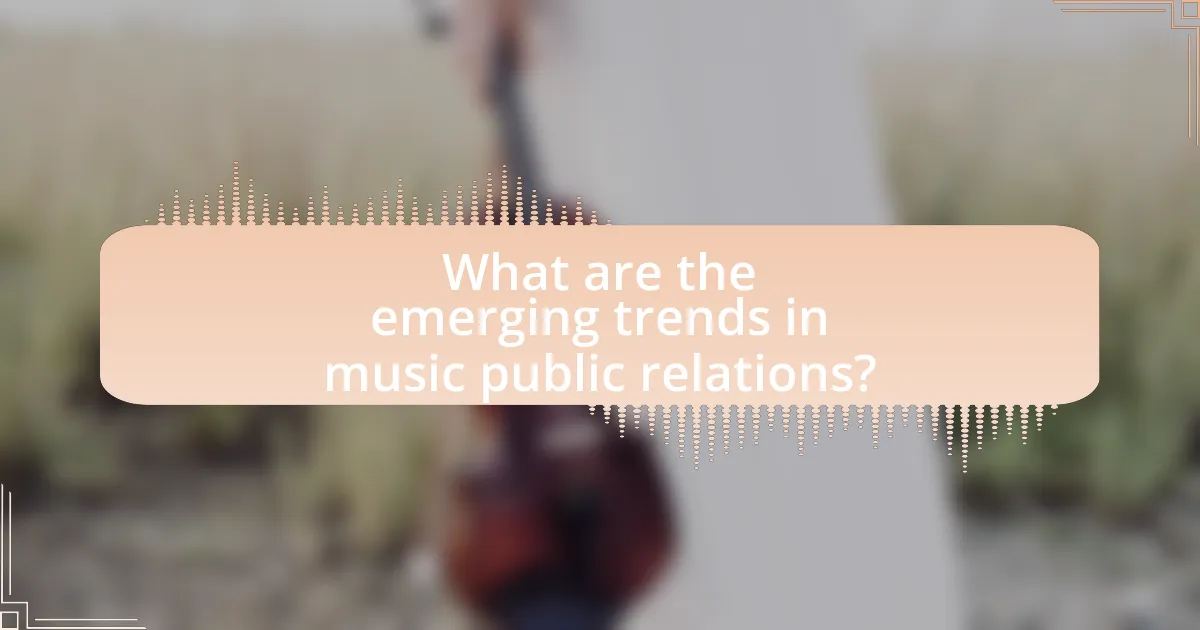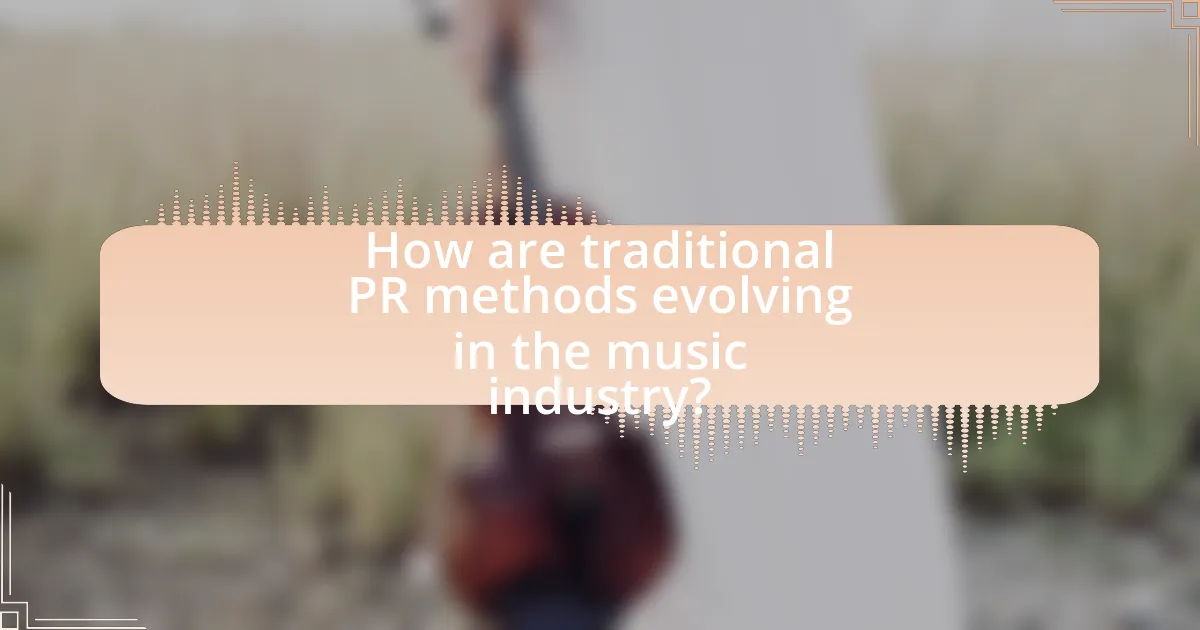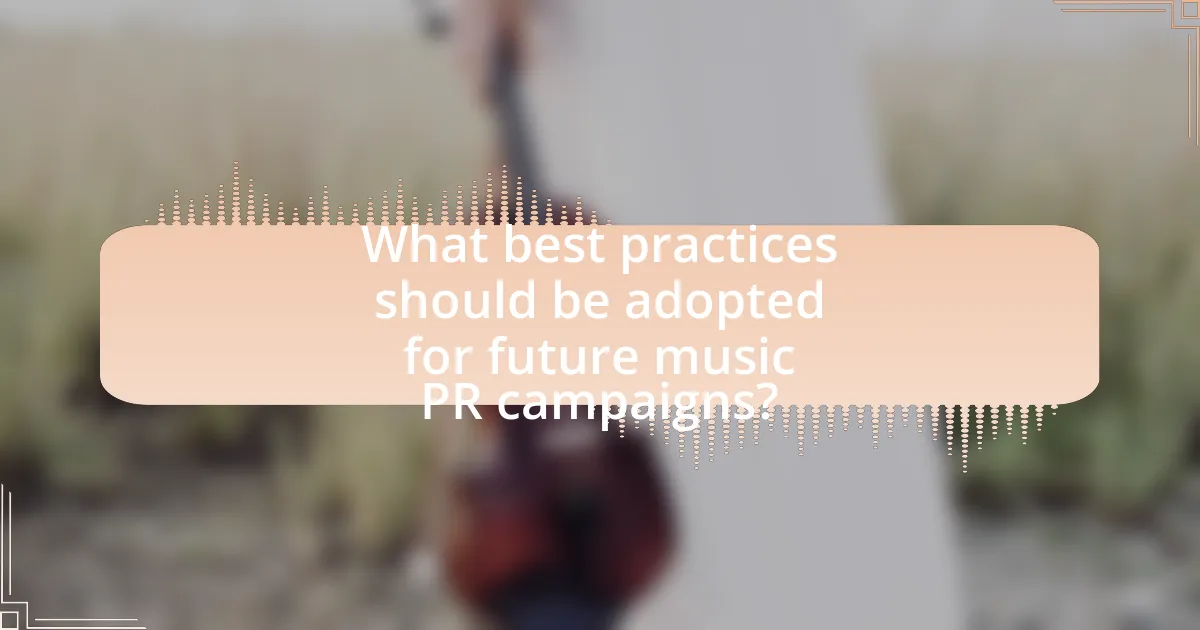The article “The Future of Music Public Relations: Trends to Watch” examines the evolving landscape of music public relations, highlighting emerging trends such as the increased use of digital platforms, data analytics, and influencer partnerships. It discusses how technology is reshaping audience engagement strategies, emphasizing the importance of social media and direct-to-fan communication. The article also addresses the limitations of traditional PR methods and the new skills required for PR professionals in the digital age. Key metrics for evaluating PR success and innovative tactics, including storytelling and audience feedback, are outlined as essential components for effective music public relations campaigns.

What are the emerging trends in music public relations?
Emerging trends in music public relations include the increased use of digital platforms, data analytics, and influencer partnerships. Digital platforms, such as social media and streaming services, have become essential for artists to engage with their audience directly, allowing for real-time feedback and interaction. Data analytics enables PR professionals to tailor campaigns based on audience insights, enhancing the effectiveness of promotional strategies. Additionally, collaborations with influencers have gained traction, as they can amplify an artist’s reach and credibility within specific demographics. These trends reflect the industry’s shift towards a more integrated and data-driven approach to public relations.
How is technology shaping the future of music public relations?
Technology is significantly shaping the future of music public relations by enhancing communication, data analytics, and audience engagement. Digital platforms enable real-time interaction between artists and fans, allowing public relations professionals to craft targeted campaigns based on audience insights. For instance, social media analytics tools provide data on listener demographics and preferences, which can inform strategic decisions. Additionally, advancements in artificial intelligence facilitate personalized marketing efforts, enabling PR teams to automate outreach and tailor messages to specific audience segments. This shift towards data-driven strategies is evidenced by the increasing reliance on platforms like Spotify and Instagram, which have become essential for promoting music and engaging with fans effectively.
What role do social media platforms play in music PR strategies?
Social media platforms are essential in music PR strategies as they facilitate direct engagement between artists and their audiences. These platforms enable musicians to share content, promote new releases, and build a fanbase through targeted advertising and organic reach. For instance, a study by the International Music Summit in 2021 indicated that 70% of music consumers discover new music through social media channels, highlighting their influence in shaping public perception and driving sales. Additionally, platforms like Instagram and TikTok have become vital for viral marketing, allowing artists to leverage trends and user-generated content to enhance visibility and connect with younger demographics.
How are data analytics influencing PR campaigns in the music industry?
Data analytics are significantly influencing PR campaigns in the music industry by enabling targeted marketing strategies and enhancing audience engagement. By analyzing streaming data, social media interactions, and demographic information, music PR professionals can tailor their campaigns to specific audience segments, ensuring that promotional efforts resonate more effectively. For instance, platforms like Spotify and Apple Music provide insights into listener behavior, allowing PR teams to identify trends and preferences that inform campaign strategies. This data-driven approach has been shown to increase engagement rates, as evidenced by a 2022 report from the International Music Summit, which indicated that campaigns utilizing data analytics saw a 30% increase in audience interaction compared to traditional methods.
What changes are occurring in audience engagement strategies?
Audience engagement strategies are increasingly shifting towards personalized and interactive experiences. This change is driven by advancements in technology, such as data analytics and social media platforms, which allow for targeted communication and real-time feedback. For instance, a report by Nielsen indicates that 63% of consumers prefer brands that offer personalized experiences, highlighting the effectiveness of tailored content in enhancing audience connection. Additionally, the rise of live streaming and virtual events has transformed how audiences interact with artists and brands, fostering a sense of community and immediacy that traditional methods lacked.
How are artists using direct-to-fan communication to enhance PR?
Artists are using direct-to-fan communication to enhance public relations by fostering personal connections and engaging their audience through social media platforms, email newsletters, and live streaming events. This approach allows artists to share exclusive content, updates, and behind-the-scenes insights, which cultivates a sense of community and loyalty among fans. For instance, a study by the Music Industry Research Association found that artists who actively engage with fans on social media see a 30% increase in fan retention and a 25% boost in ticket sales for live events. By leveraging these direct communication channels, artists can effectively manage their public image and respond to fan feedback in real-time, thereby enhancing their overall PR strategy.
What impact does live streaming have on music public relations?
Live streaming significantly enhances music public relations by providing artists with direct engagement opportunities with their audience. This real-time interaction fosters a sense of community and loyalty among fans, which is crucial for building an artist’s brand. According to a 2021 report by the International Federation of the Phonographic Industry, 50% of music consumers engaged with live streams, indicating a strong preference for this format. Additionally, live streaming allows for immediate feedback and data collection, enabling public relations professionals to tailor their strategies effectively. This shift towards digital engagement has transformed traditional PR practices, making them more dynamic and responsive to audience preferences.

How are traditional PR methods evolving in the music industry?
Traditional PR methods in the music industry are evolving through the integration of digital platforms and data analytics. This shift allows artists and labels to engage directly with audiences via social media, enhancing real-time communication and feedback. For instance, the use of targeted advertising on platforms like Instagram and TikTok enables more precise audience reach, which traditional methods lacked. Additionally, data analytics tools provide insights into listener behavior, allowing for tailored PR strategies that resonate with specific demographics. This evolution reflects a broader trend where traditional PR is increasingly supplemented by digital strategies to maximize impact and engagement.
What are the limitations of traditional music PR approaches?
Traditional music PR approaches are limited by their reliance on outdated media channels and lack of direct audience engagement. These methods often focus on press releases and traditional media coverage, which can result in a narrow reach and diminished impact in a digital-first landscape. Additionally, traditional PR tends to prioritize established artists over emerging talent, limiting opportunities for new voices. According to a 2021 report by the Music Industry Research Association, 70% of music consumers now discover new music through social media platforms, highlighting the inadequacy of traditional methods in reaching modern audiences effectively.
How do traditional media outlets adapt to the digital landscape?
Traditional media outlets adapt to the digital landscape by integrating online platforms and utilizing social media to reach broader audiences. For instance, many newspapers and television stations have developed digital versions of their content, allowing for real-time updates and interactive features. According to a Pew Research Center report, as of 2021, 86% of U.S. adults get news from a digital device, highlighting the necessity for traditional outlets to embrace digital formats to maintain relevance. Additionally, these outlets often collaborate with digital influencers and utilize data analytics to tailor content to audience preferences, ensuring they remain competitive in a rapidly evolving media environment.
What new skills are required for PR professionals in music?
PR professionals in music now require skills in digital marketing, data analytics, and social media management. As the music industry increasingly shifts towards online platforms, understanding digital marketing strategies is essential for promoting artists effectively. Data analytics skills enable PR professionals to interpret audience engagement metrics and tailor campaigns accordingly. Additionally, proficiency in social media management is crucial for building and maintaining an artist’s online presence, as platforms like Instagram and TikTok play a significant role in music promotion today.
How is the role of PR professionals changing in the music industry?
The role of PR professionals in the music industry is evolving to encompass digital engagement and data-driven strategies. As streaming platforms and social media dominate music consumption, PR professionals are increasingly focusing on online presence and audience interaction. For instance, the rise of TikTok has shifted promotional efforts towards creating viral content that resonates with younger audiences, demonstrating the need for adaptability in communication strategies. Additionally, PR professionals are leveraging analytics to measure campaign effectiveness and audience reach, ensuring that their efforts align with changing consumer behaviors. This shift reflects a broader trend in the industry where traditional media relations are supplemented by innovative digital tactics to enhance artist visibility and engagement.
What new responsibilities do music publicists have in the digital age?
Music publicists in the digital age have new responsibilities that include managing social media presence, engaging with online communities, and utilizing data analytics to measure campaign effectiveness. These responsibilities arise from the shift towards digital platforms where artists and their music are promoted through social media channels, streaming services, and online publications. For instance, publicists must now create targeted content for platforms like Instagram and TikTok, which requires an understanding of trends and audience engagement metrics. Additionally, they are expected to analyze data from digital campaigns to refine strategies and improve outreach, reflecting the growing importance of measurable results in public relations.
How can PR professionals leverage influencer partnerships effectively?
PR professionals can leverage influencer partnerships effectively by aligning brand values with the right influencers to enhance authenticity and reach. By selecting influencers whose audience demographics match the target market, PR professionals can ensure that the messaging resonates. For instance, a study by the Digital Marketing Institute found that 49% of consumers depend on influencer recommendations, highlighting the effectiveness of this strategy. Additionally, establishing clear communication and collaboration goals with influencers can lead to more impactful campaigns, as evidenced by successful partnerships that resulted in increased engagement and brand awareness.

What best practices should be adopted for future music PR campaigns?
Future music PR campaigns should adopt a data-driven approach to target audiences effectively. Utilizing analytics tools allows PR professionals to identify listener demographics, preferences, and behaviors, which can enhance campaign strategies. For instance, a study by Nielsen Music found that targeted marketing can increase engagement rates by up to 30%. Additionally, integrating social media platforms for real-time interaction fosters community building and enhances artist visibility. According to a report by Hootsuite, 54% of social media users prefer to engage with brands through these platforms, making them essential for music PR. Lastly, collaborating with influencers who resonate with the target audience can amplify reach and credibility, as evidenced by a survey from Influencer Marketing Hub, which states that 63% of marketers believe influencer partnerships are effective in reaching new audiences.
How can artists and labels effectively measure PR success?
Artists and labels can effectively measure PR success by analyzing key performance indicators (KPIs) such as media coverage, audience engagement, and social media metrics. Media coverage can be quantified by tracking the number of articles published, the reach of those articles, and the sentiment expressed within them. Audience engagement is assessed through metrics like event attendance, streaming numbers, and fan interactions on social media platforms. Social media metrics, including likes, shares, and comments, provide insight into how well the audience is responding to PR efforts. For instance, a study by the Public Relations Society of America found that 70% of PR professionals use media impressions and engagement metrics to evaluate success, highlighting the importance of these KPIs in measuring the effectiveness of PR campaigns in the music industry.
What metrics are most relevant for evaluating music PR campaigns?
The most relevant metrics for evaluating music PR campaigns include media coverage, social media engagement, audience reach, and conversion rates. Media coverage quantifies the number of articles, reviews, and features published about the artist or album, indicating the campaign’s visibility. Social media engagement measures likes, shares, comments, and overall interaction on platforms, reflecting audience interest and connection. Audience reach assesses the total number of individuals exposed to the campaign through various channels, providing insight into potential fan growth. Conversion rates track actions taken by the audience, such as streaming, downloads, or ticket purchases, demonstrating the campaign’s effectiveness in driving tangible results. These metrics collectively provide a comprehensive view of a campaign’s impact and success in the music industry.
How can feedback loops improve future PR strategies?
Feedback loops can significantly enhance future PR strategies by enabling continuous improvement through real-time data analysis and audience engagement. By systematically collecting and analyzing feedback from campaigns, PR professionals can identify what resonates with their target audience, allowing for more tailored and effective messaging. For instance, a study by the Institute for Public Relations found that organizations that actively seek and incorporate feedback into their strategies see a 30% increase in audience engagement. This iterative process not only refines messaging but also builds stronger relationships with stakeholders, ultimately leading to more successful PR outcomes.
What innovative tactics can enhance music public relations efforts?
Innovative tactics that can enhance music public relations efforts include leveraging social media influencers, utilizing data analytics for targeted campaigns, and creating immersive experiences through virtual reality. Social media influencers can amplify an artist’s reach, as 49% of consumers depend on influencer recommendations, according to a study by Nielsen. Data analytics allows PR teams to identify audience preferences and tailor messaging effectively, leading to higher engagement rates. Additionally, immersive experiences, such as virtual reality concerts, have been shown to increase fan interaction and loyalty, with a report from PwC indicating that the global VR market in entertainment is expected to reach $45 billion by 2025. These tactics collectively enhance visibility and engagement in the competitive music industry landscape.
How can storytelling be utilized in music PR campaigns?
Storytelling can be utilized in music PR campaigns by creating a compelling narrative that connects artists with their audience on an emotional level. This approach enhances audience engagement, as narratives can evoke feelings and foster a sense of community among fans. For instance, artists like Taylor Swift have successfully used storytelling in their PR strategies by sharing personal experiences and behind-the-scenes insights, which resonate with listeners and build loyalty. Research indicates that campaigns incorporating storytelling can increase audience retention by up to 65%, demonstrating the effectiveness of this strategy in enhancing brand identity and audience connection in the music industry.
What role does audience feedback play in shaping PR strategies?
Audience feedback is crucial in shaping PR strategies as it provides insights into public perception and preferences. By analyzing audience reactions through surveys, social media interactions, and engagement metrics, PR professionals can tailor their messaging and campaigns to better resonate with their target demographics. For instance, a study by the Public Relations Society of America found that organizations that actively incorporate audience feedback into their strategies see a 30% increase in campaign effectiveness. This data underscores the importance of audience feedback in refining PR approaches to align with audience expectations and enhance overall communication effectiveness.
What are the key takeaways for successful music public relations?
Successful music public relations hinge on strategic storytelling, targeted audience engagement, and leveraging digital platforms. Effective storytelling creates a compelling narrative around the artist or music project, which resonates with audiences and media alike. Targeted audience engagement ensures that PR efforts reach the right demographics, maximizing impact and relevance. Additionally, leveraging digital platforms, such as social media and streaming services, allows for broader reach and real-time interaction with fans. These strategies are supported by the fact that 78% of music consumers engage with artists on social media, highlighting the importance of digital presence in modern PR efforts.